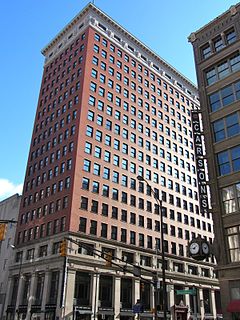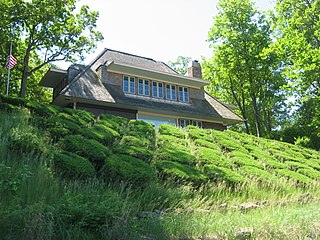
The Riverside Historic District is a U.S. historic district located in downtown Evansville, Indiana. It was added to the register in 1978 and roughly bounded by Southlane Drive, Walnut, Third, and Parrett Streets. It consists of 1,010 acres (4.1 km2) and 425 buildings. It is also known as the Riverside Neighborhood.

The Barnes and Thornburg Building is a high rise in Indianapolis, Indiana originally known as the Merchants National Bank Building. In 1905, the Merchants National Bank and Trust Company engaged the architectural firm of D. H. Burnham & Company of Chicago to design a new bank headquarters on the southeastern corner of the Washington and Meridian streets, the most important intersection in Indianapolis. Initial occupancy of the lower floors took place in 1908, while the upper floors were not completed until 1912.

The Joseph J. Cole Jr. House and 1925 Cole Brouette No. 70611 are a house and historic motor car located at 4909 N. Meridian Street in Indianapolis, Indiana. The house, also known as Colehaven, dates from 1924 and reflects Late 19th and 20th Century Revivals architecture and French Renaissance architecture. The 1.3-acre (0.53 ha) property includes the house and one other contributing structure.

Lincoln Street Historic District is a national historic district located at Gary, Indiana. The district encompasses 239 contributing buildings in an exclusively residential section of Gary. They were largely built between 1910 and 1950, and many reflect the American Small House Movement. Architectural styles include examples of Colonial Revival, Late Gothic Revival, Spanish Colonial Revival, and Bungalow / American Craftsman architecture.

Jefferson Street Historic District is a national historic district located at Gary, Indiana. The district encompasses 81 contributing buildings in an exclusively residential section of Gary. They were largely built between 1922 and 1945, and many reflect the American Small House Movement. Architectural styles include examples of Colonial Revival, Tudor Revival, Late Gothic Revival, Spanish Colonial Revival, and Bungalow / American Craftsman architecture.

Crawford-Winslow House is a historic home located at Crown Point, Lake County, Indiana, USA. It was built in 1890, and is a 2½-story, Queen Anne style frame dwelling with a cross gable roof with fishscale shingles. It features a corner tower with conical roof, wraparound porch, and leaded glass windows. Also on the property is a contributing garage.

George John Wolf House, also known as the Wolf-Knapp House, is a historic home located at Hammond, Lake County, Indiana. The house was built in 1929–1930, and is a two-story, roughly "L"-shaped, Tudor Revival style limestone dwelling with a slate roof. It features a two-story round tower with a conical roof enclosing a winding staircase.

Francis P. Keilman House is a historic home located at St. John, Lake County, Indiana. It was built about 1857, and is a two-story, side hall plan balloon frame dwelling with Italianate style design elements. It has a front gable roof and a rear addition built about 1900. Also on the property are the contributing wood frame stable with a garage addition and a wood frame rabbit hutch.

Roselawn–Forest Heights Historic District is a national historic district located at Hammond, Lake County, Indiana. The district encompasses 107 contributing buildings in a predominantly residential section of Hammond. It developed between about 1922 and 1962, and includes notable example of Colonial Revival, Tudor Revival, Bungalow / American Craftsman, and American Small House and eclectic styles of residential architecture. Located in the district is the separately listed George John Wolf House.

Glendale Park Historic District is a national historic district located at Hammond, Lake County, Indiana. The district encompasses 13 contributing buildings and 1 contributing site in an exclusively residential section of Hammond. It developed between about 1905 and 1926, and includes notable example of Colonial Revival, Tudor Revival, Prairie School and Bungalow / American Craftsman styles of residential architecture. The houses are arranged along a parkway with Glendale Park in the center.

Hoover-Timme House is a historic home located at Long Beach, LaPorte County, Indiana. It was designed by architect John Lloyd Wright and built in 1929. It is a three level house carved into a sand dune on the shore of Lake Michigan. The house is in a rambling Prairie School style with hipped and mansard roof forms. The house is sheathed in ashlar sandstone and stucco. Also contributing is the house site.

Lowell E. and Paula G. Jackson House, also known as the House of Tile, is a historic home located at Long Beach, LaPorte County, Indiana. It was designed by architect John Lloyd Wright and built in 1938. The house is constructed of 12 inch square clay tiles painted green and carved into a sand dune on the shore of Lake Michigan. The house has horizontal clapboard siding and is in the International Style of architecture. The house has three levels and a carport. Also contributing is the house site.

George and Adele Jaworowski House, also known as Early Birds, is a historic home located in Michigan Township, LaPorte County, Indiana. It was designed by architect John Lloyd Wright and built in 1945–1946. The house is atop and carved into a sand dune on the shore of Lake Michigan. The house is in the Prairie School of architecture and has a high pitched hipped roof with wide overhanging eaves and dormer. Also contributing is the house site.

Plymouth Northside Historic District is a national historic district located at Plymouth, Marshall County, Indiana. The district encompasses 141 contributing buildings, 2 contributing sites, 6 contributing structures, and 3 contributing objects in a predominantly residential section of Plymouth. It developed between about 1870 and 1940, and includes examples of Italianate, Gothic Revival, Queen Anne, Colonial Revival, Tudor Revival, Neoclassical, and Renaissance Revival style architecture. Located in the district is the separately listed Marshall County Courthouse. Other notable contributing resources include Magnetic Park, First United Methodist Church (1914-1915), J.C. Capron House (1900), Samuel Schlosser House (1910-1911), Clay Metsker House (1917-1918), Plymouth Church of the Brethren (1950-1951), Logan-Stanley Fountain, Stevens House (1895), and First Presbyterian Church (1896-1897).

Plymouth Southside Historic District is a national historic district located at Plymouth, Marshall County, Indiana. The district encompasses 91 contributing buildings, 2 contributing structures, and 1 contributing object in a predominantly residential section of Plymouth. It developed between about 1853 and 1953, and includes examples of Italianate, Greek Revival, Queen Anne, Colonial Revival, and Tudor Revival style architecture. Notable contributing resources include the John McFarlin, Jr., House, Trinity United Methodist Church (1926), Bible Baptist Church (1894), Felke Florist and Greenhouse (1922), John Soice Residence, Westervelt-Marble Residence, and Edwards-Gambel Residence (1856).

Daniel Stout House, also known as the Old Stone House and Hubert Brown House, is a historic home located in Bloomington Township, Monroe County, Indiana. It was built in 1828, and is a two-story, stone dwelling representative of a pioneer farmhouse. It is believed that its builder Daniel Stout also helped to build Grouseland at Vincennes, Indiana. The house was restored in the 1940s.

Good Fellow Club Youth Camp is a historic summer camp and a national historic district located at Porter, Porter County, Indiana. The district encompasses nine contributing buildings, seven contributing structures, and one contributing site built by U.S. Steel for its employees' children. The contributing resources include the camp site with roadways and foundations of removed buildings, administration building, gate house and flagstone wall (1946), caretaker's house and garage (1941), pool house (1946), steel footbridge, steel swimming pool (1946), riflery, and tennis courts (1946). The buildings reflect the Adirondack rustic and American Craftsman architectural styles. The camp remained in operation until 1976, and is now part of the Indiana Dunes National Lakeshore.

Horner–Terrill House is a historic home located at Indianapolis, Indiana. It was built about 1875, and is a 2+1⁄2-story, roughly "L"-shaped, Second Empire style brick dwelling with limestone detailing. It features a three-story tower, mansard roof, and round arched openings. Also on the property is a contributing garage. It was listed on the National Register of Historic Places in 2013.

Holy Rosary–Danish Church Historic District, also known as Fletcher Place II, is a national historic district located at Indianapolis, Indiana. The district encompasses 183 contributing buildings in a predominantly residential section located in the central business district of Indianapolis. It was developed between about 1875 and 1930, and include representative examples of Italianate, Gothic Revival, Tudor Revival, and Renaissance Revival style architecture. Located in the district is the separately listed Horace Mann Public School No. 13. Other notable buildings include the John Kring House, Trinity Danish Evangelical Lutheran Church (1872), John Wands House (1857), Henry Homburg House, Samuel Keely House, Maria Wuensch Cottage, and Holy Rosary Catholic Church (1911-1925).

Gaseteria, Inc., also known as ACLU, Indiana, historic apartment building located at Indianapolis, Indiana. It was built in 1941, and is a one-story, Art Moderne style, buff-color and red brick building with limestone detailing and a flat roof. It features curved walls and glass-block windows. It was built to house the offices of the Gaseteria filling station company.
























